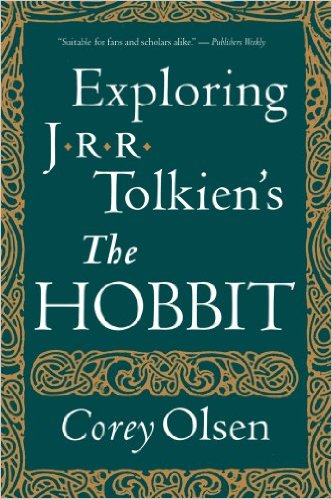Exploring J.R.R. Tolkien’s The Hobbit

Corey Olsen. Exploring J.R.R. Tolkien’s The Hobbit. Houghton Mifflin, 2012. 336 pp. $25 (softcover).
Reviewed by David D. Oberhelman.
Corey Olsen is no doubt known to many Mythprint subscribers for his lively podcasts in The Tolkien Professor series and for the online lecture courses he and other scholars provide through the Mythgard Institute. Indeed, Olsen, an assistant professor at Washington College in Maryland, has devoted himself to bringing Tolkien scholarship to the public, offering entertaining yet highly penetrating analyses of Tolkien’s work for a general audience of readers. Olsen uses his talents as a lecturer in his first book, Exploring J.R.R. Tolkien’s The Hobbit, in which he offers a chapter-by-chapter analysis of The Hobbit, approaching Tolkien’s first novel for children on its own terms and not as a mere prequel to the grander narrative of The Lord of the Rings.
Olsen focuses his discussion on the original 1937 edition of The Hobbit, what he terms the “solo stage”, and the “revision stage” of the book published in 1951 (i.e., the second edition) in which Tolkien, who was deep into the subsequent story of the One Ring, made some crucial changes to the text — most notably the “Riddles in the Dark” chapter — to bring the earlier work in line with the later one. Olsen does not extend his discussion into the “assimilation stage” of The Hobbit and consequently steers clear of Tolkien’s later writings on the adventures of Bilbo and the dwarves which place those events into the context of the War of the Ring and the earlier history of Middle-earth. Indeed, readers looking for a comprehensive overview of The Hobbit in relation to the body of Tolkien’s writings about his secondary universe may be somewhat disappointed; those readers might start with Douglas Anderson’s The Annotated Hobbit and John Rateliff’s The History of The Hobbit, which both provide comprehensive investigations into the different stages of composition and the relationship of the Hobbit material to the legendarium as a whole. Yet for those who want insightful commentary on The Hobbit as a work that stands on its own as a valuable contribution to children’s literature, Olsen will be an enjoyable and astute guide.
As he progresses through the chapters of The Hobbit, Olsen traces certain themes such as Bilbo’s choices, luck and providence in his adventures, and the changes in tone as the stakes become greater throughout the course of the novel. Olsen combines insightful commentary on the action with close readings of significant passages, especially of the songs that play an important role in the narrative which far too many readers unfortunately gloss over or skip altogether. His discussion of the “silly” singing elves of Rivendell highlights the differences between these High Elves and the lower ones of Mirkwood, and illustrates how “we are experiencing something fundamentally outside human experience” (296), though some readers may be left wanting the rest of the story about those unusual beings. Olsen gives an excellent account of the “Riddles in the Dark” exchange between Bilbo and Gollum, showing how the riddles they tell reflect their vastly different experiences but also the common ground that unites them. Here Olsen notes the changes this chapter underwent from 1937 to the second edition, but does not dwell upon the transformation of Gollum into the conflicted, Ring-afflicted character we meet in The Lord of the Rings. This commentary does not focus on the earlier, discarded versions of the tale (as John Rateliff does in his detailed examination of the various stages of composition for The Hobbit), but Olsen nevertheless does discover how in the catalogue of epithets Bilbo gives himself during his conversation with Smaug vestiges of an abandoned episode with the spiders of Mirkwood peek through the later revisions. Such moments of critical insight mixed with Olsen’s conversational style will appeal to Tolkien novices and even experts, making this companion worth the shelf space in even the most discerning Hobbit specialist’s library.
As an introduction to The Hobbit, Olsen’s book, like his successful podcasts, helps make Tolkien accessible to the general public and shows how one can appreciate the charms and messages of this classic without regarding it as merely a lesser part of the larger cycle of Middle-earth. Olsen will not overwhelm new readers with too much information, but hopefully will leave them wanting to discover more of what Tolkien has to offer them. ≡

